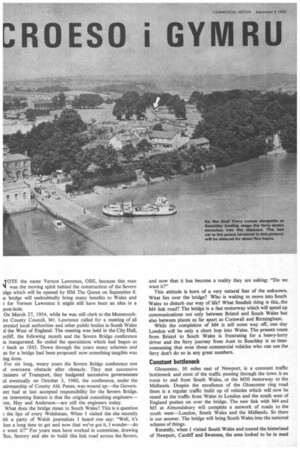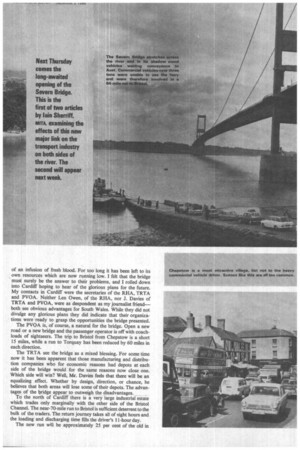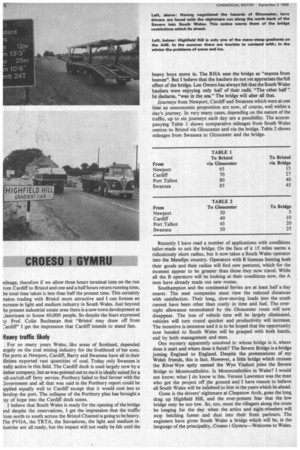:TOTE the name Vernon Lawrence, OBE, because this man Ni
Page 76

Page 77

Page 78

If you've noticed an error in this article please click here to report it so we can fix it.
was the moving spirit behind the construction of the Severn idge which will be opened by HM The Queen on September 8. le bridge will undoubtedly bring many benefits to Wales and t for Vernon Lawrence it might still have been an idea in a ;eon-hole.
On March 27, 1954, while he was still clerk to the Monmouthire County Council, Mr. Lawrence called for a meeting of all :crested local authorities and other public bodies in South Wales d the West of England. The meeting was held in the City Hall, xrdiff, the following month and the Severn Bridge conference is inaugurated. So ended the speculation which had begun as r back as 1845. Down through the years many schemes and es for a bridge had been proposed: now something tangible was ing done.
For six long, weary years the Severn Bridge conference met id overcame obstacle after obstacle. They met successive linisters of Transport, they badgered successive governments( id eventually on October 5, 1960, the conference, under the rairmanship of County Aid. Panes, was wound up—the Governent had at last accepted responsibility for the Severn Bridge. ne interesting feature is that the original consulting engineers— [on, Hay and Anderson—are still the engineers today.
What does the bridge mean to South Wales? This is a question the lips of every Welshman. When I visited the site recently ith a party of Welsh journalists I heard one say: "Well, it's ken a long time to get and now that we've got it, I wonder—do e want it?" For years men have worked in committee, drawing lice, factory and site to build this link road across the Severn, and now that it has become a reality they are asking: "Do we want it?"
This attitude is born of a very natural fear of the unknown. What lies over the bridge? Who is waiting to move into South Wales to disturb our way of life? What fiendish thing is this, the M4 link road? The bridge is a fast motorway which will speed up communications not only between Bristol and South Wales but also between places as far apart as Cornwall and Birmingham.
While the completion of M4 is still some way off, one day London will be only a short hop into Wales. The present route from Bristol to South Wales is frustrating for a heavy-lorry driver and the ferry journey from Aust to Beachley is so timeconsuming that even those commercial vehicles who can use the ferry don't do so in any great numbers.
Constant bottleneck Gloucester, 30 miles east of Newport, is a constant traffic bottleneck and most of the traffic passing through the town is en route to and from South Wales, or the M50 motorway to the Midlands. Despite the excellence of the Gloucester ring road there is a regular traffic build up of vehicles which will now be eased as the traffic from Wales to London and the south west of England pushes on over the bridge. The new link with M4 and M5 at Almondsbury will complete a network of roads to the south west—London, South Wales and the Midlands. So there is our answer. The bridge will bring South Wales into the national scheme of things.
Recently, when I visited South Wales and toured the hinterland of Newport, Cardiff and Swansea, the area looked to be in need
of an infusion of fresh blood. For too long it has been left to its own resources which are now running low. I felt that the bridge must surely be the answer to their problems, and I rolled down into Cardiff hoping to hear of the glorious plans for the future. My contacts in Cardiff were the secretaries of the RHA, TRTA and PVOA. Neither Len Owen, of the RHA, nor J. Davies of TRTA and PVOA, were as despondent as my journalist friend— both see obvious advantages for South Wales. While they did not divulge any glorious plans they did indicate that their organizations were ready to grasp the opportunities the bridge presented.
The PVOA is, of course, a natural for the bridge. Open a new road or a new bridge and the passenger operator is off with coachloads of sightseers. The trip to Bristol from Chepstow is a short 15 miles, while a run to Torquay has been reduced by 60 miles in each direction.
The TRTA see the bridge as a mixed blessing. For some time now it has been apparent that those manufacturing and distribution companies who for economic reasons had depots at each side of the bridge would for the same reasons now close one. Which side will win? Well, Mr. Davies feels that there will be an equalizing effect. Whether by design, direction, or chance, he believes that both areas will lose some of their depots. The advantages of the bridge appear to outweigh the disadvantages.
To the north of Cardiff there is a very large industrial estate which trades only marginally with the other side of the Bristol Channel. The near-70-mile run to Bristol is sufficient deterrent to the bulk of the traders. The return journey takes all of eight hours and the loading and discharging time fills the driver's 11-hour day.
The new run will be approximately 25 per cent of the old in nileage, therefore if we allow three hours terminal time on the run rom Cardiff to Bristol and one and a half hours return running time, he total time taken is less than half the present time. This certainly nakes trading with Bristol more attractive and I can foresee an ncrease in light and medium industry in South Wales. Just beyond he present industrial estate area there is anew town development at iantrisant to house 60,000 people. So despite the fears expressed )y Prof. Colin Buchanan that "Bristol may draw off from L'ardiff" I get the impression that Cardiff intends to stand fast.
Heavy traffic likely
For so many years Wales, like areas of Scotland, depended argely on the coal mining industry for the livelihood of her sons. The ports at Newport, Cardiff, Barry and Swansea have all in their ifetirne exported vast quantities of coal. Today only Swansea is .eally active in this field. The Cardiff dock is used largely now by a imber company, but as was pointed out to me it is ideally suited for a .oll-on/roll-off ferry service. Portbury failed to find favour with the :3overnment and all that was said in the Portbury report could be tpplied equally well to Cardiff except that it would cost less to levelop the port. The collapse of the Portbury plan has brought a 'ay of hope into the Cardiff dock scene.
I believe that South Wales is ready for the opening of the bridge Ind despite the reservations, I get the impression that the traffic -rom north to south across the Bristol Channel is going to be heavy. The PVOA, the TRTA, the Stevadores, the light and medium inJustries are all ready, but the impact will not really be felt until the heavy boys move in. The RHA sees the bridge as "manna from heaven". But I believe that the hauliers do not yet appreciate the full effect of the bridge. Len Owens has always felt that the South Wales hauliers were enjoying only half of their radii. "The other half ". he declares, "was in the sea." The bridge will alter all that.
Journeys from Newport, Cardiff and Swansea which were at one time an uneconomic proposition are now, of course, well within a day's journey. In very many cases, depending on the nature of the traffic, up to six journeys each day are a possibility. The accompanying Table 1 shows comparative mileages from South Wales centres to Bristol via Gloucester and via the bridge. Table 2 shows mileages from Swansea to Gloucester and the bridge.
Recently I have read a number of applications with conditions tailor-made to suit the bridge. On the face of it 15 miles seems a ridiculously short radius, but it now takes a South Wales operator into the Mendips country. Operators with B licences limiting both their goods and their radius will find new pastures, which for the moment appear to be greener than those they now travel. While all the B operators will be looking at their conditions now, the A men have already made out new routes.
Southampton and the continental ferries are at least half a day nearer. The steel companies must view the reduced distances with satisfaction. Their long, slow-moving loads into the south cannot have been other than costly in time and fuel. The overnight allowance necessitated by the Gloucester route will now disappear. The loss of vehicle time will be largely eliminated, vehicles will turn round quicker and productivity will increase. The incentive is immense and it is to be hoped that the opportunity now handed to South Wales will be grasped with both hands, and by both management and men.
One mystery apparently unsolved is: whose bridge is it, where does it start and where does it finish? The Severn Bridge is a bridge joining England to England. Despite the protestations of my Welsh friends, this is fact. However, a little bridge which crosses the River Wye aptly named the Wye Viaduct joins the Severn Bridge to Monmouthshire. Is Monmouthshire in Wales? I would not know; what I do know is this. Vernon Lawrence was the man who got the project off the ground and I have reason to believe all South Wales will be indebted to him in the years which lie ahead.
Gone is the drivers' nightmare at Chepstow Arch, gone the long drag up Highfield Hill, and the ever-present fear that the low bridge may be too low. So, too, must the villagers along the route be longing for the day when the artics and eight-wheelers will stop belching fumes and dust into their front parlours. The engineers have given South Wales a bridge which will be, in the language of the principality, Croeso i Gymru—Welcome to Wales.
































































































































